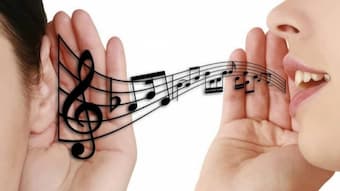
© whs-blogs.co.uk
I often describe music as a language; it is in my opinion the purest of all. As are its intentions and purpose. This is how I approach creating and performing music; as a means to exchange my ideas and feelings. Indeed, and as just as in any other languages, music is a medium of communication. Music expresses ideas and opinions, as well as the intentions of the mind and the heart. And there are no translations needed. Indeed, the richness of it resides in its universality and ability to be felt and understood by all, on many levels. Although history has tried to tie music to human ideas and controversies — whether political, social etc. —, it ultimately stands on its own. It brings all human beings to the same level; the one of experiencing. So, what are the points of similitude between this language, and let’s say English for instance? And how is music indeed a language?
Without entering the long, complex and multi-faceted process of defining music, let’s, for the purpose of this article, conveniently jump to the following conclusion: music is organised sounds — or noises. The primary elements that compose music are the following: rhythm, melody, harmony, dynamics, tone colour, texture and form. These seven elements weave a complex fabric of sounds which altogether create the language of music and allow the musician to form his own musical words and sentences.
Parallelly, language can be simply defined as organised sounds or noises. It is a method of communication based on words used in a structured and conventional way. And just like music, there are elements that compose this language: phonemes (units of sound that distinguish one word from another), morphemes (units of sound that cannot be further divided), lexemes (lexical units consisting of one or several words), syntax (the arrangement of words and phrases), and context, as well as grammar, semantics, and pragmatics. It is through these spoken and written arrangements of sounds that one expresses himself.
Having identified the elements that constitute both music and language, it is therefore a matter of connecting the dots and drawing the analogy between both forms of communication.
Phonemes and morphemes both constitute vocabulary, and it cannot be more obvious when it comes to music rhythms and melodies. Harmony, texture and form are nothing more than the syntax of music; the way sounds, melodies and chords are arranged in order to make sense together; how a musician decides to organise his sounds in order to convey his message.
When it comes to dynamics, tone colour or texture, one can only understand it the same way that accentuation provides understanding and clarity between ideas. It is a matter for the musician to decide how to express the message that he has formed.

A composer or an improviser chooses his musical words
and sentences very carefully © The Economist
Just like there are different discourses that are appropriate depending on the context, music works on a background of understanding. A composer or an improviser chooses his musical words and sentences very carefully: one would not write an atonal melody over a baroque counterpoint, unless the confusion is intentional!
Having made a point at identifying the linguistic similarities between spoken languages and music, one should acknowledge the existence of actual musical languages too. They are based on musical sounds and focus on pitch bends. Such languages can be found in the Solresol language — also called langue universelle — of François Sudre and the Moss language of composer Jackson Moore. During the 1970s, the prog-rock group Magma invented a language called Kobaïan based on sonorities.
MAGMA – Hortz Fur Dehn Stekehn West
To understand how much music is a language, one should simply observe how musicians communicate and understand each other, especially when it comes to improvised music.
If the end result of both languages is different — one cannot argue on the usefulness and somehow importance of both languages — their goal is inarguably the same; to convey a message, ideas or thoughts. While it seems perhaps less obvious and natural to the learner, the language of music surely becomes more and more coherent as the ear develops, and the result is a strength of emotions and feelings that is at times stronger than any other spoken languages in the world.
For more of the best in classical music, sign up to our E-Newsletter
J.S. Bach: Invention No. 3 in D Major, BWV 774 (János Sebestyén, piano)
